Queen Anne’s Lace Jelly with Currants
This post may contain affiliate links. Read my full disclosure here.
While gathering this year’s currant harvest, I had a vision. What if I combined Queen Anne’s lace jelly with currants for a unique seasonal treat? I could picture the clear jelly with bright red berries suspended in it for a pop of color and flavor. All I needed to do was figure out a way to make it happen.

Luckily, I had one of my dearest friends visiting and a cool summer day. We started canning and cooking and made a day of it. The results of the experiment were delicious.

Queen Anne’s lace jelly is delicate and floral with a hint of peach flavor. The bright acidity of the currants is a perfect compliment. The tricky part is getting the berries suspended in the jelly instead of floating at the top, which is accomplished by cooling the jelly until it just starts to set.
If you’re in a hurry and don’t care too much about appearance, you can add the currants right away and stir them in at serving time. If you don’t have currants, I suspect red raspberries would also work well, or you can make the jelly without added berries.

This jelly is made with Queen Anne’s Lace flowers, not roots or leaves. Make sure you have Queen Anne’s lace (wild carrot) and not a poisonous lookalike, such as poison hemlock. Avoid getting queen Anne’s lace sap on your skin, as it may cause phytophotodermatitis.
For more information on identifying the flowers, see “Queen Anne’s Lace – Weekly Weeder #6“.
Check out “Currants – Growing, Harvesting, and Uses” for currant tips.
CAUTION: Pregnant women should not consume Queen Anne’s lace in any form, as it may cause uterine contractions.
Queen Anne’s Lace Jelly Recipe with Currants
Delicate and floral with a pop of tartness from the currants, this jelly is a unique treat.
Ingredients
- 20 large, fresh Queen Anne’s lace heads
- 4 cups water
- 1/4 cup lemon juice – fresh is great if you have it
- 1 package powdered pectin, such as Sure-Jell
- 3 1/2 cups granulated cane sugar
- 2 tablespoons fresh currants per cup jar (10-12 tablespoons), cleaned and dried
Directions
Bring water to boil. Remove from heat. Add flower heads and push them down into the water. Cover and steep 30 mins.
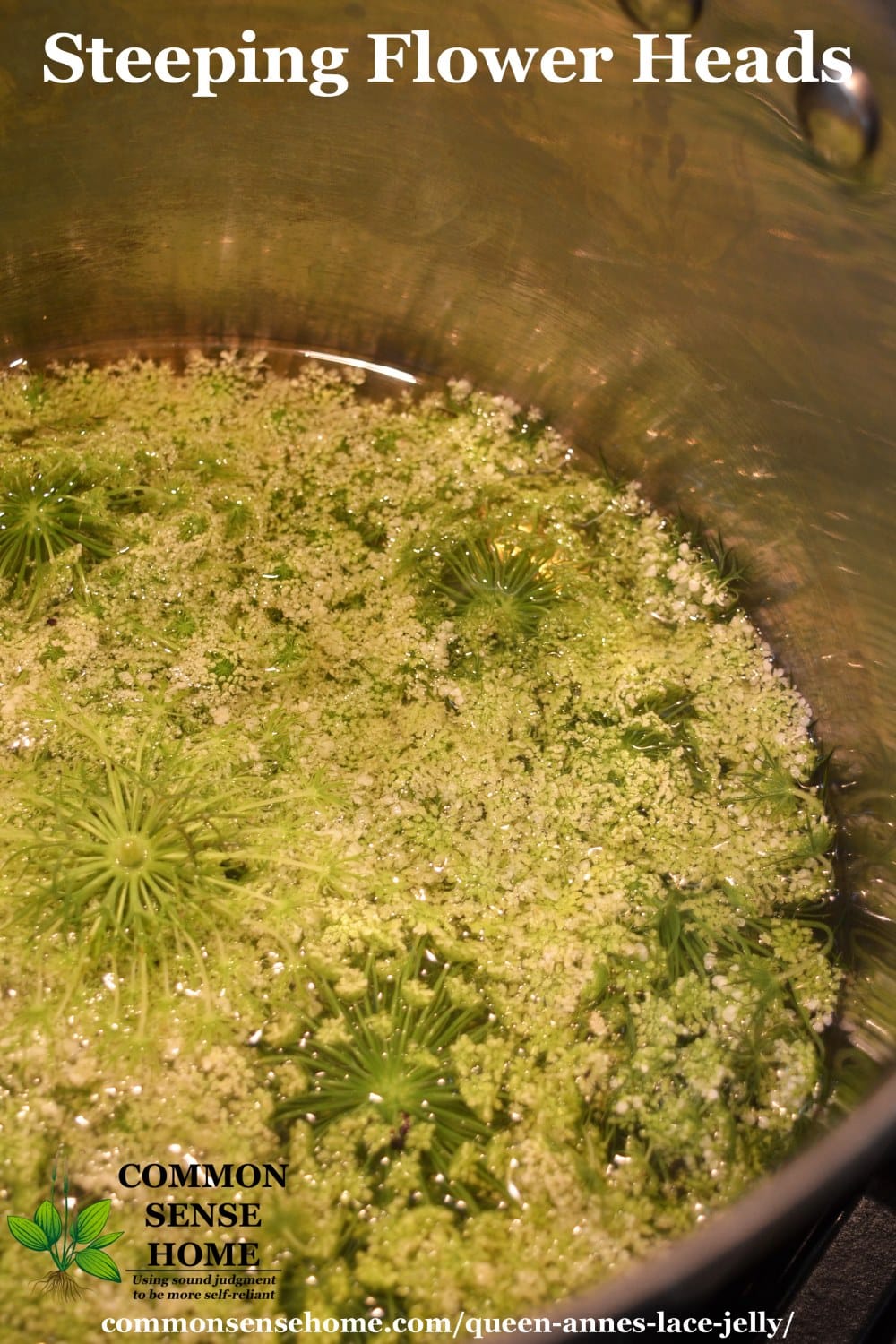
Strain through cheese cloth or flour sack towel. (The flower heads are loaded with pollen, so a kitchen strainer won’t do.) The flower “tea” will be light green/brown. At this point, the resulting brew smells like a combination of carrots and fish. Don’t panic!
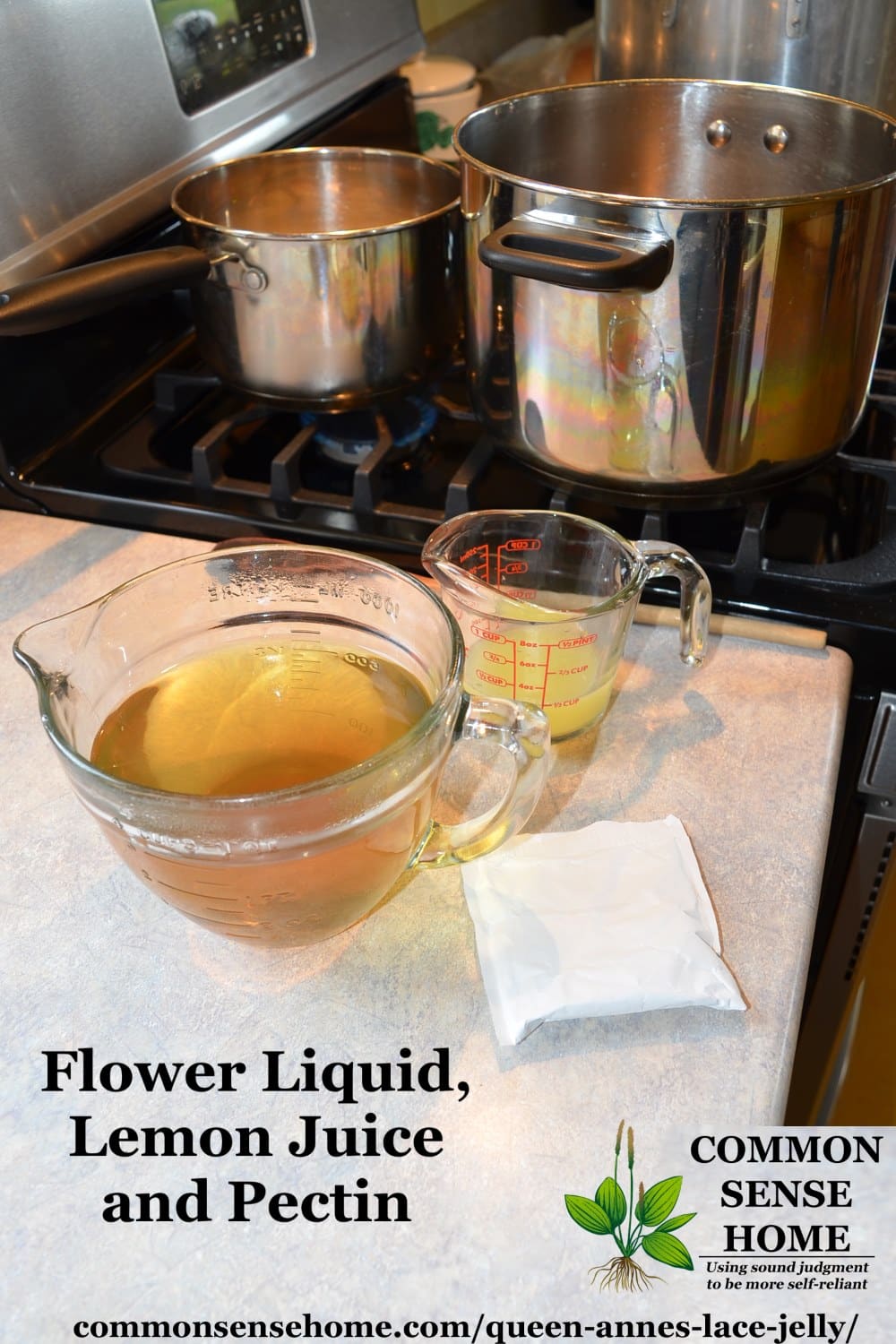
Would you like to save this?
Measure 3 cups of the liquid into 4-6 quart pan. Add the lemon juice and pectin.
The liquid will change from green/brown to light pink when the lemon is added, and the aroma changes from fishy to floral. It’s strange, but true. I’ve never had a jelly change so dramatically during processing.
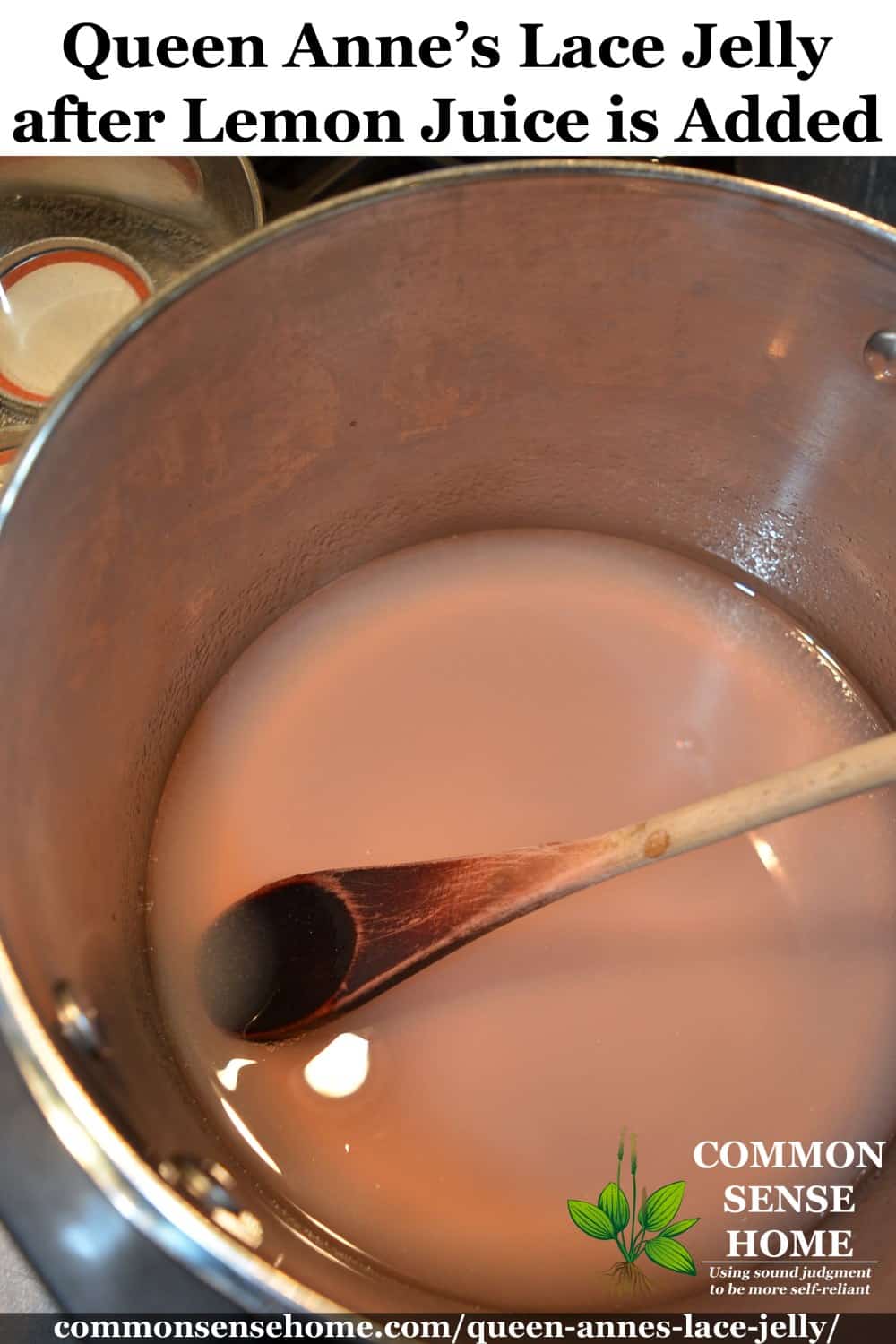
Bring mixture to a rolling boil, stirring constantly. Add sugar. Cook and stir until mixture comes to a rolling boil. Maintain boil for one minute, and then remove from heat. Skim foam, if desired.
If you don’t have currants and want to make plain Queen Anne’s lace jam:
Pour jelly into jars leaving 1/4″ head space. Wipe rims and seat two piece lids. Process in hot water bath for 10 minutes in a boiling water bath canner.
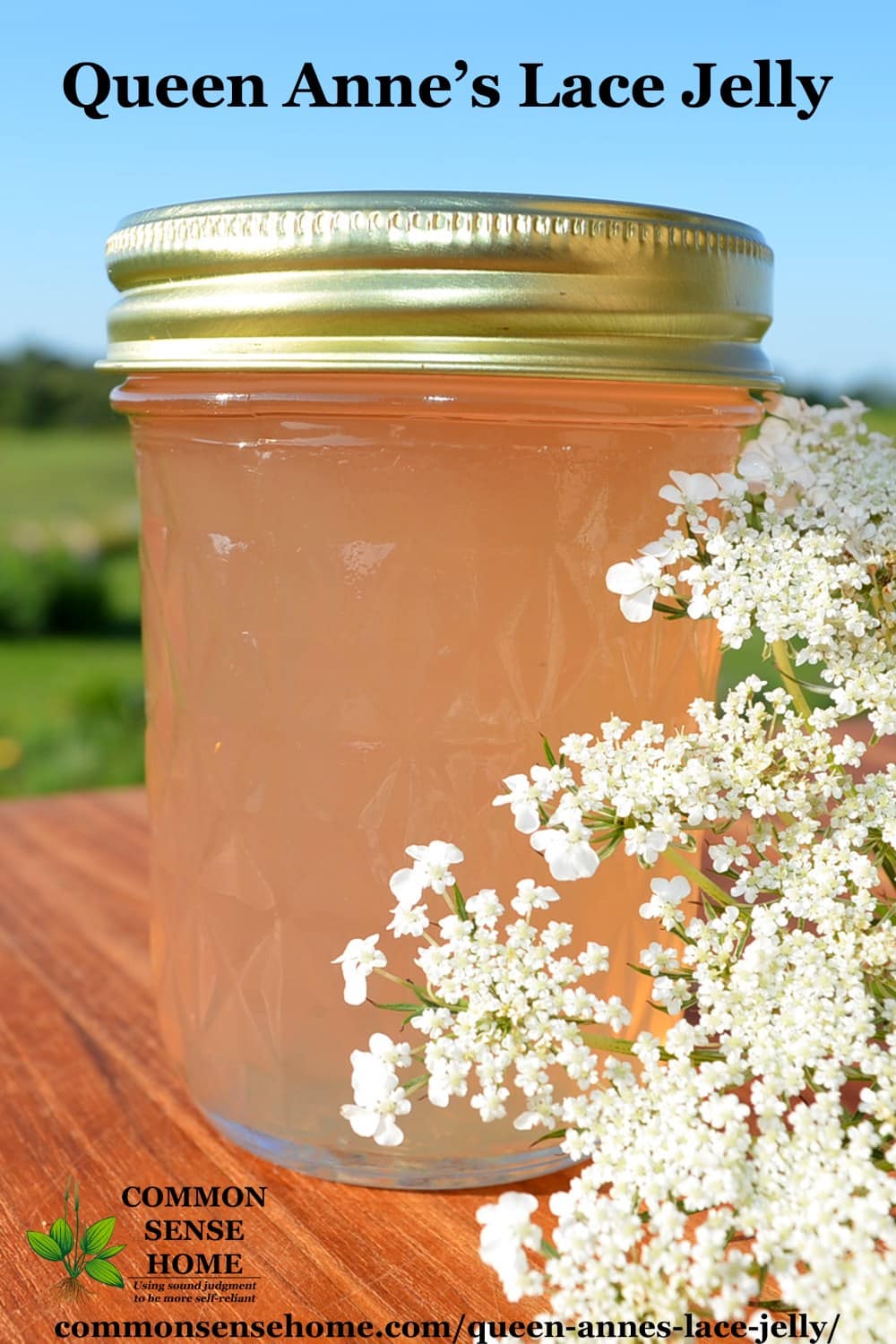
If you want to include the currants:
Allow jelly to cool to the point where it begins to set up. (Pour into another container and place into the refrigerator to speed this up.)
Once jelly has started to set, pour about a half inch into the bottom of each jar, add a tablespoon of currants, repeat. Give jelly a gentle stir to suspect the currants.
Top of jars with jelly, leaving 1/4″ headspace. Wipe rims and seat two piece lids. Process in hot water bath for 10 minutes in a boiling water bath canner.
Note: The addition of the unprocessed currants will cause some weeping in the jam, so skip the currants for long term storage. With currants, use within 6 months.
Makes 5-6 8-oz jars.
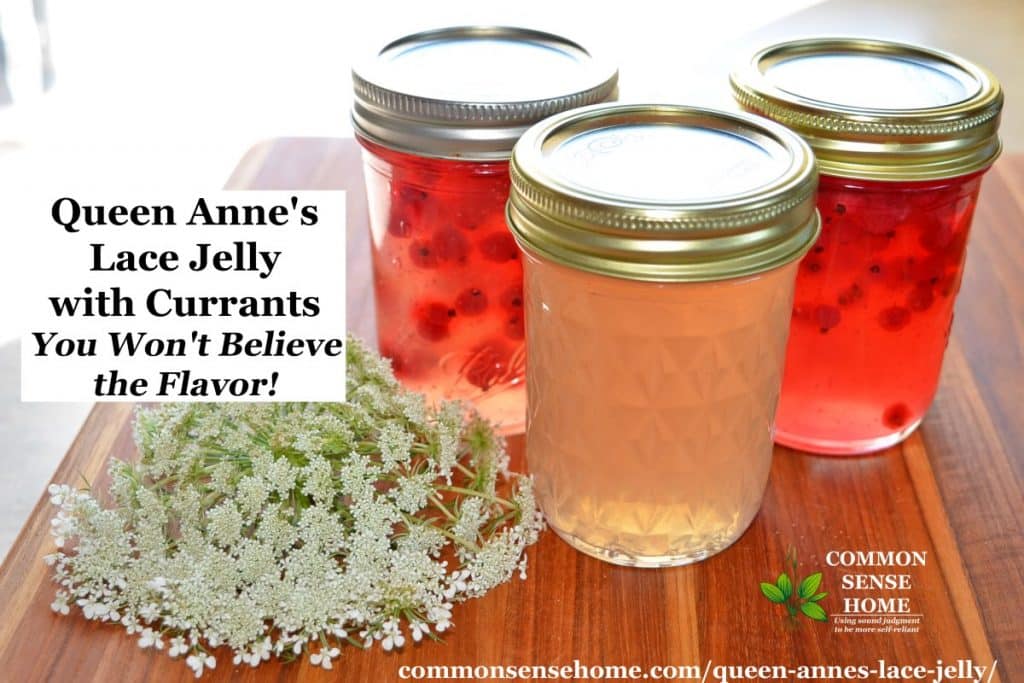
More Homemade Jam, Jelly and Fresh Baked Bread…
Almost everyone in the house loved this jelly – except my husband, who thought it was too floral. (He doesn’t like pineapple on his pizza, either, silly guy. 😉 ) I thought the flavor was AMAZING, and the jars look beautiful. Best of all, I have another use for my wildflowers and currants.
If you like homemade jams and jellies, check our full listing of over 20 Homemade Jam, Jelly and Spread recipes. We also have a great assortment of homemade bread recipes.
You may also enjoy:
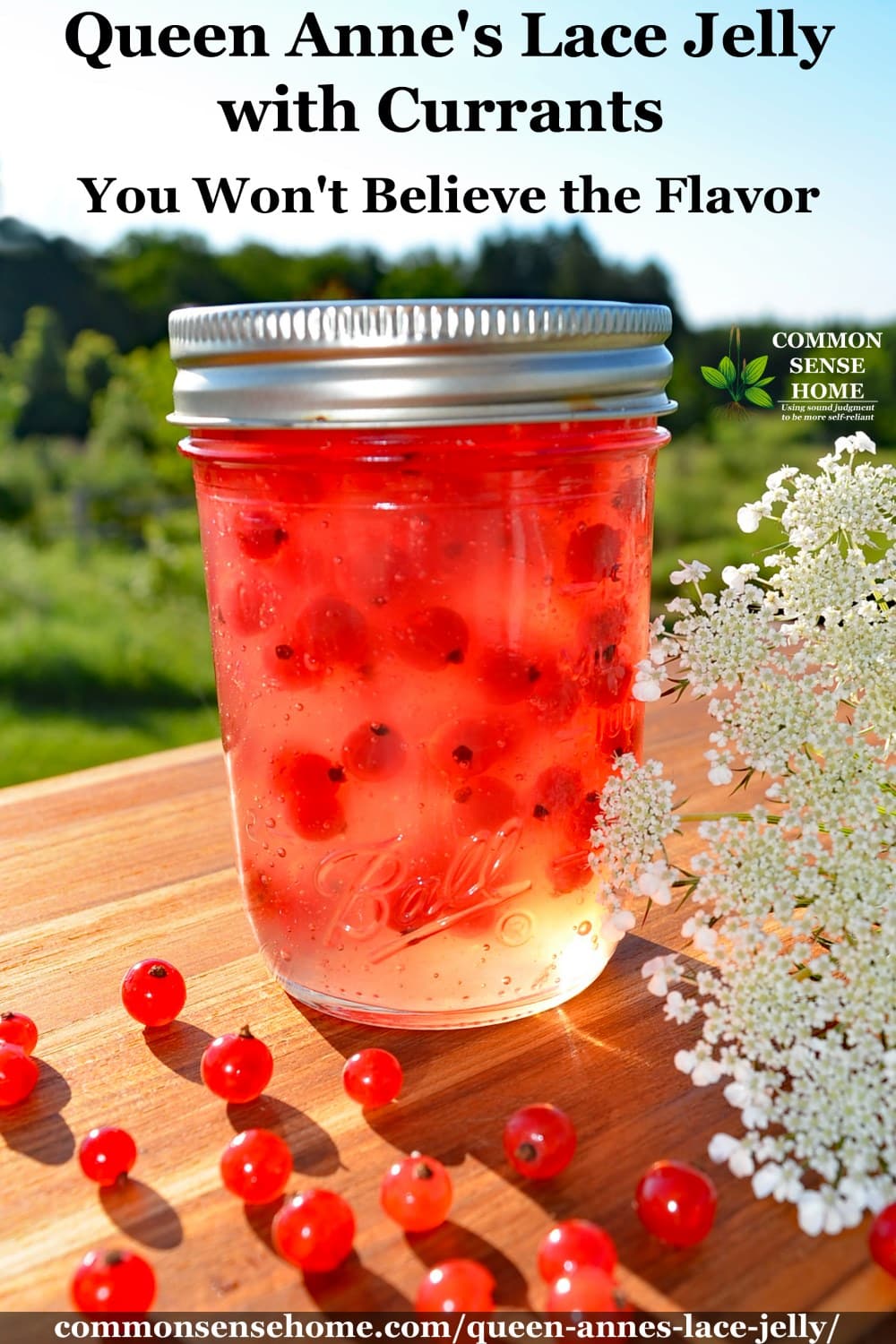
Queen Anne’s Lace Jelly with Currants
Queen Anne’s Lace Jelly with Currants – The bright acidity of currants is a perfect compliment to the delicate floral flavor of Queen Anne’s lace jelly.
- Yield: 5–6 cups 1x
Ingredients
- 20 large, fresh Queen Anne’s lace heads
- 4 cups water
- 1/4 cup lemon juice – fresh is great if you have it
- 1 package powdered pectin, such as Sure-Jell
- 3 1/2 cups granulated cane sugar
- 2 tablespoons fresh currants per cup jar (10–12 tablespoons), cleaned and dried
Instructions
Bring water to boil. Remove from heat. Add flower heads and push them down into the water. Cover and steep 30 mins. Strain through cheese cloth or flour sack towel.
Measure 3 cups of the liquid into 4-6 quart pan. Add the lemon juice and pectin.
Bring mixture to a rolling boil, stirring constantly. Add sugar. Cook and stir until mixture comes to a rolling boil. Maintain boil for one minute, and then remove from heat. Skim foam, if desired.
If you don’t have currants and want to make plain Queen Anne’s lace jam:
Pour jelly into jars leaving 1/4″ head space. Wipe rims and seat two piece lids. Process in hot water bath for 10 minutes in a boiling water bath canner.
If you want to include the currants:
Allow jelly to cool to the point where it begins to set up. (Pour into another container and place into the refrigerator to speed this up.) Once jelly has started to set, pour about a half inch into the bottom of each jar, add a tablespoon of currants, repeat. Give jelly a gentle stir to suspect the currants. Top of jars with jelly, leaving 1/4″ headspace. Wipe rims and seat two piece lids. Process in hot water bath for 10 minutes in a boiling water bath canner.
Notes
The addition of the unprocessed currants will cause some weeping in the jam, so skipping the currants is better for long term storage.

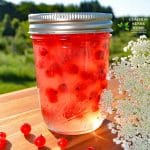
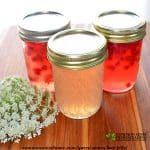
I can’t seem to get my hands on ACTUAL Queen Anne’s lace and can only find false queen anne’s lace. Is it safe to use that? Or are they both the same, essentially? I really really want to make this jelly.
I have never worked with false queen Anne’s lace, but it looks like the Ammi species are edible, even though they are not related to the Carota species (queen Anne’s lace).
Yummmmm…. Everything worked like a dream. Your recipe thought of everything and contributed to the success of my first attempt at Queen Anne’s Lace jelly with red currants.
Would small tart blueberries work as a substitute for the currants? I really want to make this recipe with the fruit but currants don’t grow in my area. Thanks!
Yes, they should work.
Red currants have an average pH of 2.8 (range 2.5 to 3.2).
Blueberries range from around 3.1 – 3.4, and I’m guessing the ones you have are at the lower end of that range.
Woah I made this jelly and I’m soooo proud. It’s really good but I only gave it 4 stars cause it’s a tad sweet. If I make it again (it makes A LOT), i think I’d reduce the sugar by about 1 or 1/2 a cup. Although, i used flowers a little late in the season. Theyre smaller so I used about 30 to 40 instead. And some were greenish and from my carrot plants. That might’ve made it a little weaker I dont know. It’s my first time making jelly. I also accidentally got pectin for low sugar jelly that’s activated by calcium. It did work judging by how it’s set along the pot (the rest isnt done yet). I used 4t calcium water and 4t pectin. I added the calcium water with the lemon juice and then the pectin with the sugar. Probably shoulda followed the directions and mixed the pectin into the sugar cause it kinda got chunky. I mixed it with a wisk super hard but it didnt completely dissolve and it doesnt strain out… Whoops. I was also torn between letting it steep for 30minutes or 3 hours as said in other sites and one of these comments, so I went with 3 hours and it worked out great although the smell wasnt that different so idk. Either way it worked out great and was super easy and I will definitely be making more jelly! Thank you so much for this recipe. Completely blew my mind when I added the lemon and calcium(I wont spoil what happens 🙂 and then again with the sugar. Smelled kinda like cranberries but tastes nothing like it?!?! Anyway super fun and thank you it was great.
Definitely worth it to take the time to mix the sugar and pectin. Cutting the sugar shouldn’t be an issue.
Lol yeahh. Thank you
Wow, just wow, living in Nc I have been admiring these flowers for years, had I known you can eat them, I would have been doing it for a life time. This jelly is awesome, and easy. I used the whiter looking heads and I made it into a tea as well, just do it….
I’m glad you enjoyed the jelly. I always enjoy finding new uses for wild plants.
I made the jelly & my family LOVES it!! Your directions were easy to follow. I have more flowers steeping right now for a 3rd batch of it. I made a regular version (full sugar), a low sugar batch, & am going to make another LS batch.
Glad that it’s working well.
I make queen annes lace jelly. Let it steep (blooms) for at least 1 to 3 hours. You will get a gorgeous plum colored tea with a scent that is heavenly… not brown or green with a carrot smell
Thanks for the tip.
Correct me if I’m wrong or have been mislead all of these years but isn’t Queen Anne’s Lace poisonous? This really looks good and sounds devine and I would really like to try making it but really have my doubts. Please ease my mind ????
You can read more about queen anne’s lace here – https://commonsensehome.com/queen-annes-lace/
The sap can cause phytophotodermatitis, and pregnant women should not use queen anne’s lace because it may cause uterine contractions. (The risk would be very low with something like this jelly, but I just updated the post to reflect this issue.)
I just made this jelly and it was wonderful. Ive been making jelly for quite some time and was very surprised. I highly recommend it.
I’m so glad you enjoyed it!